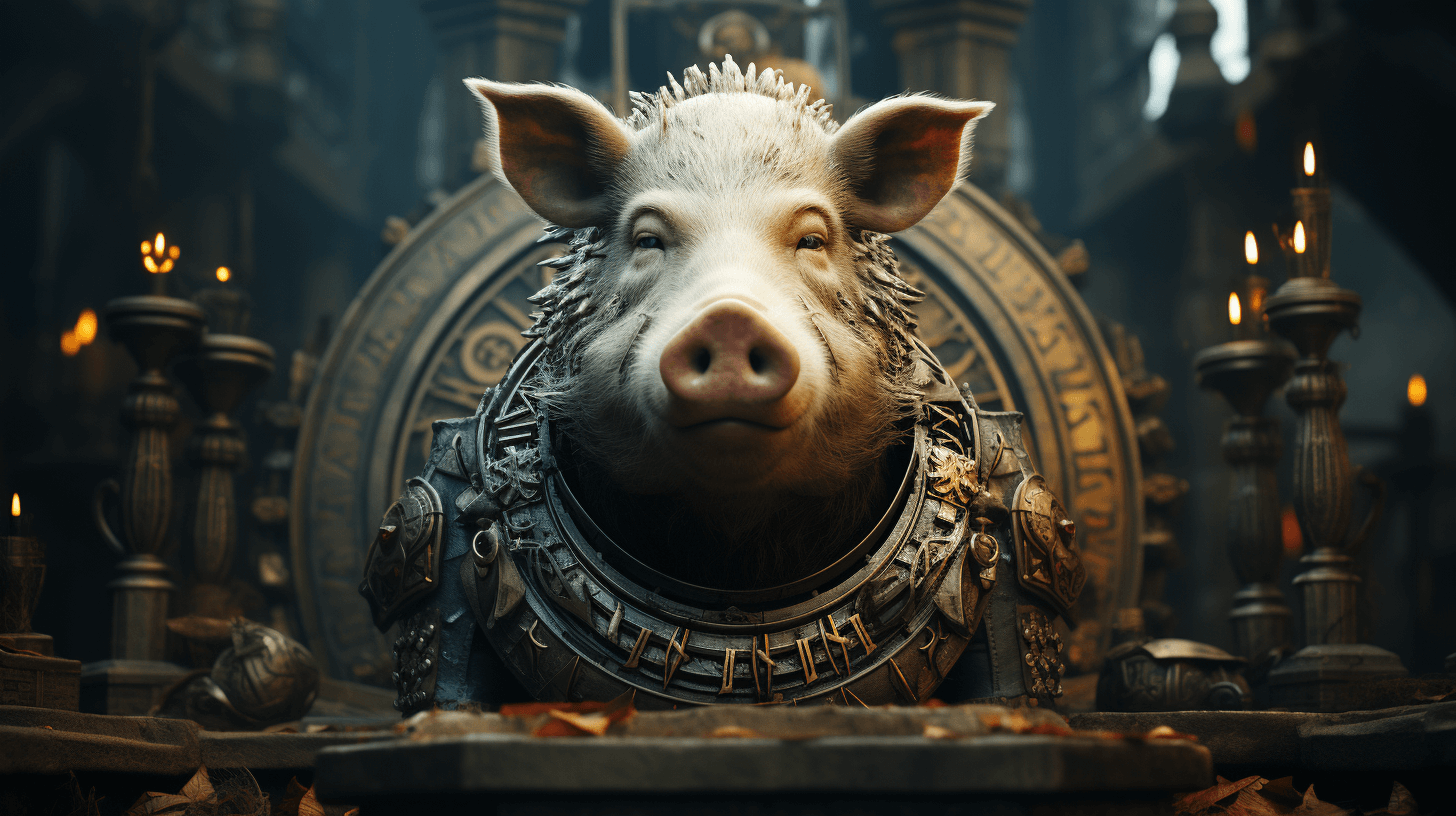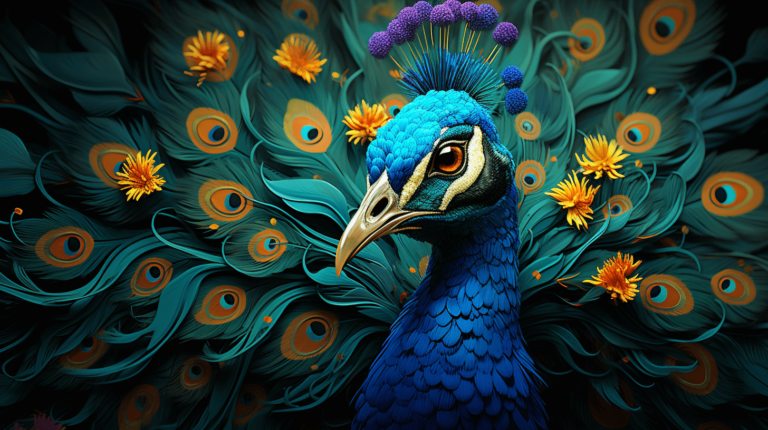The Pig, as a Symbol
The pig, as a symbol, holds various meanings across different cultures, histories, and contexts. Here’s a detailed breakdown:
Prosperity and Wealth: In many cultures, especially in Chinese tradition, the pig is a symbol of prosperity, wealth, and abundance. This stems from agricultural societies where the health and number of one’s livestock, including pigs, were directly related to one’s wealth.
Chinese Zodiac: The pig is one of the 12 animals of the Chinese zodiac. People born in the Year of the Pig are believed to have certain traits, such as being compassionate, generous, diligent, and calm.
Gluttony and Laziness: Due to their behavior and eating habits, pigs have sometimes been associated with overindulgence, gluttony, and laziness in some cultures.
Sacrifice and Rituals: Pigs were commonly used in sacrifices in various ancient cultures, including the Celts and ancient Greeks, symbolizing an offering to the divine.
Intelligence and Social Behavior: Pigs are known to be intelligent animals. They have complex social structures and can exhibit behaviors such as problem-solving.
Transformation and Utility: Almost every part of the pig can be used, from its meat to its bristles. This utility and transformation can symbolize making the most out of a situation or being resourceful.
Taboos and Religious Prohibitions: In some religious traditions, especially in Islam and Judaism, the consumption of pork is prohibited. This stems from various theological and historical reasons.
Luck: In some cultures, the pig, or even just parts of it, like a pig’s foot, are considered lucky charms.
Fertility: Due to their ability to produce large litters, pigs are sometimes associated with fertility and abundance.
Nurturing: The image of a sow with her piglets can symbolize motherhood, protection, and nurturing.
Dirt and Impurity: Pigs are often seen rolling in mud (primarily to cool off and protect their skin from the sun). This behavior, combined with their eating habits, led to associations with dirt, impurity, or being unclean in some cultures.
Popular Culture and Stories: Pigs feature in many stories, fables, and popular culture references. “The Three Little Pigs” fable, for example, teaches lessons about work ethic and planning for the future.
The Pig’s Stomach
The pig’s stomach, or more commonly referred to as “pig’s tripe,” holds specific cultural, culinary, and symbolic meanings. Here’s a detailed examination of its symbolism and usage:
Culinary Delicacy: In many cultures, the pig’s stomach is considered a delicacy and is used in various dishes. Its unique texture is prized in cuisines from around the world, such as in Chinese soups or stuffed in traditional Pennsylvania Dutch cooking.
Resourcefulness and Sustainability: The use of every part of the animal, including the stomach, showcases a culture’s or society’s resourcefulness and respect towards the animals they consume. It is a testament to the idea of waste not, want not.
Rites and Rituals: In some cultures, specific parts of the animal, including the stomach, have been used in rituals, either as offerings or as part of ceremonial meals.
Purity and Cleaning: In a more symbolic or metaphoric sense, the stomach, responsible for digestion and processing food, can be seen as a symbol of purification – taking in the sustenance and filtering out toxins or impurities.
Confronting Taboos: For some, the very idea of consuming offal, including the pig’s stomach, is a taboo or at least a culinary challenge. Facing this can be a form of confronting one’s fears or cultural boundaries.
Comfort and Tradition: For those who grew up with dishes made from pig’s stomach, it might symbolize comfort food, nostalgia, and cultural or familial traditions.
Health and Nutrition: Offal is often rich in nutrients. Traditional dishes that use parts like the stomach often arose from an understanding of their nutritional value, even if that understanding wasn’t scientific in the modern sense.
Affordability: Historically, offal was sometimes more affordable than prime cuts of meat. So dishes made from pig’s stomach might have origins in more working-class or peasant traditions.
Transformation: Culinary techniques often transform the stomach from something possibly seen as unappealing to a dish that’s rich in flavor and texture. This process can symbolize the broader idea of transformation – turning the ordinary or overlooked into something special.
Pig’s Skeleton
A pig skeleton, like any animal skeleton, can carry a variety of symbolic meanings based on different cultural, personal, and contextual interpretations. Here are some possible interpretations:
Mortality and the Transience of Life: As with any skeletal figure, a pig skeleton is a potent symbol of death, serving as a reminder of life’s impermanence and the inevitability of mortality.
Sacrifice and Utilization: Pigs are commonly used for food in many cultures around the world. Thus, a pig skeleton could represent the concept of sacrifice, or it could symbolize complete utilization, the idea of using every part of an animal out of respect for its sacrifice.
Greed and Gluttony: Pigs are often associated with traits like greed and gluttony in various cultures. A pig skeleton, therefore, could symbolize the consequences of such excessive behavior, representing the idea that greed or over-indulgence can lead to a metaphorical ‘death’ – such as the end of relationships, opportunities, or even one’s health.
Transformation and Renewal: In some cultures, death is not seen as an end but as a part of a cycle of death and rebirth. In this context, a pig skeleton could symbolize transformation, change, or renewal.
Underlying Reality or Truth: A skeleton represents the core structure that supports life but is usually hidden from view. Similarly, a pig skeleton could symbolize the underlying reality or truth of a situation that might be unpleasant or typically hidden away.
As always, the exact interpretation can vary widely based on the context in which this symbol appears and the cultural or personal beliefs of the individual interpreting it.
The Dream of Fighting with a Baby Pig
In the dream where one fights with a baby pig and hits it in the stomach four times, we can attempt to derive some general symbolic meaning.
Baby Pig: Pigs traditionally symbolize both greed and abundance, but a baby pig might also signify something in its nascent state, vulnerability, or innocence.
Act of Fighting: Conflict in dreams often represents inner turmoil or a struggle with an aspect of oneself or external situation in waking life.
Hitting in the Stomach: The act of hitting something or someone in the stomach can represent a desire to address deep-seated emotions or gut feelings, given that the stomach area is often related to gut instincts or primary emotions.
Number Four: The number four is often seen as a number of stability and foundation (like the four corners of a square or the cardinal directions). Striking the pig four times might suggest a systematic or deliberate approach to whatever the pig represents.
Guilt or Regret: Hurting a vulnerable or innocent creature might indicate feelings of guilt, remorse, or regret over an action or thought in your waking life.
Confrontation with Innocence: The act of fighting with a baby animal might symbolize a conflict between one’s more aggressive, adult side and a more innocent, perhaps childish part of oneself.
When interpreting a dream, it’s essential to consider personal feelings, experiences, and context.







